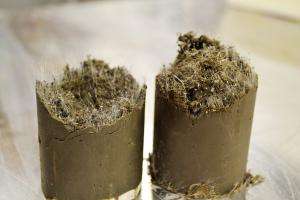Researchers give unstable soils a carpeting

A new, more environmentally-friendly practice for soil strengthening, using recycled carpet, could see the construction industry substantially decrease its carbon footprint thanks to research from the UTS Centre for Built Infrastructure Research.
With rapid population growth and urban development comes increased demands to build and expand infrastructure such as highways, railways and ports. Unfortunately, this also means the availability of appropriate sites with suitable soil to build upon is becoming scarcer.
More than 15 per cent of Australia is covered by expansive soils that constantly move up and down due to cycles of wetting and drying from the weather. Each year more than 30,000 houses crack resulting in significant insurance claims.
Cracks caused by swelling and shrinkages underneath foundations built on more volatile soils, such as Sydney's clay, are estimated to cost more than $100 million in damages each year in Australia alone.
At the same time, Australia is reported to annually dump 15 million tonnes of waste from municipal, construction, demolition, commercial and industrial sections into landfills – a large proportion of which is carpet.
What if you could kill off two environmental time bombs with one solution? The UTS Geomechanics Research Group is proposing to do just that. Their world-first research shows that they can reduce the cement content required to stabilise expansive soils by also mixing in recycled geofibres from carpet normally destined for landfill and in doing so, reduce the carbon footprint from the construction.
"We've found that adding recycled carpet fibre can curtail the shrinkage of highly expansive soils much more than cement," said project leader, Dr Behzad Fatahi. "A mere 0.5 per cent addition of carpet fibres can reduce the cement usage by 40 per cent. This means cement content can be halved when 1 per cent of carpet fibre is added and the overall carbon footprint is therefore noticeably reduced."
The UTS Geomechanics Research Group's research has also found that the brittleness index is decreased with the use of fibre content and that fibre reinforced cemented soil can undergo large deformation before total collapse.
"This gives users much more warning in the case of overloading, particularly for foundations susceptible to large structural loads such as heavy road and rail embankments, earthquakes or typhoons," said Fatahi.
"By introducing waste fibres we're facilitating the reduction of the shrinkage potential of cement treated soils, and our two goals of utilising recycling materials and minimising cement usage are achieved concurrently."
Provided by University of Technology, Sydney




















